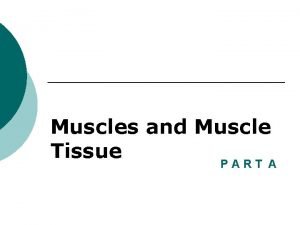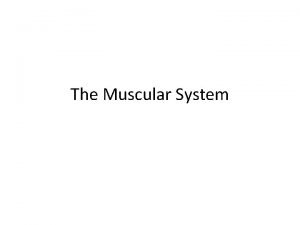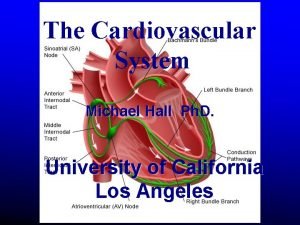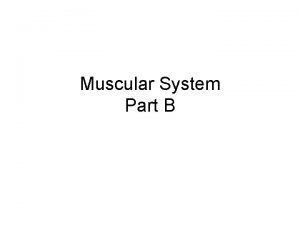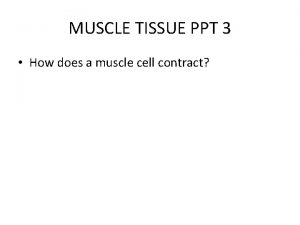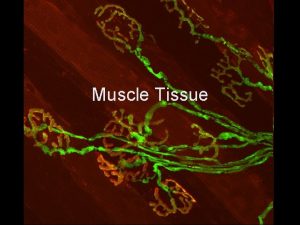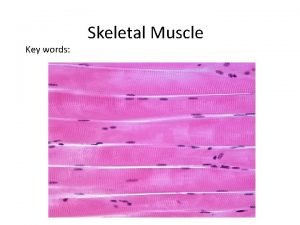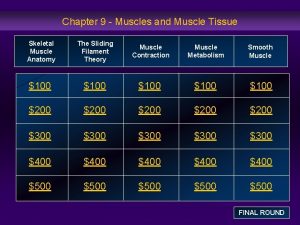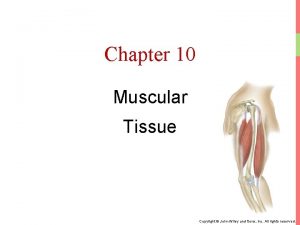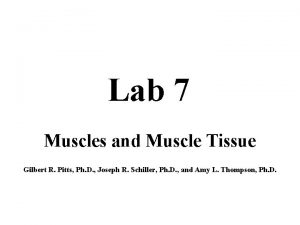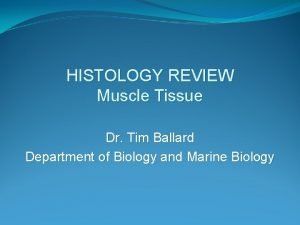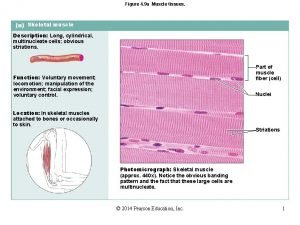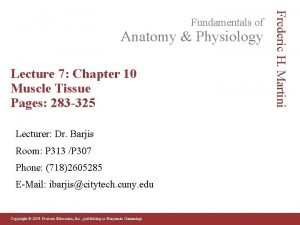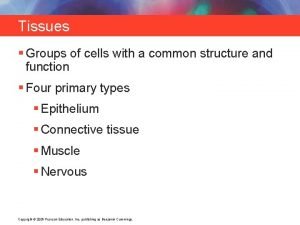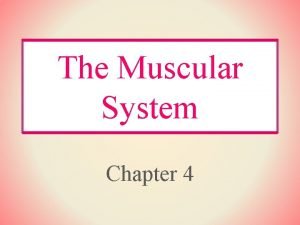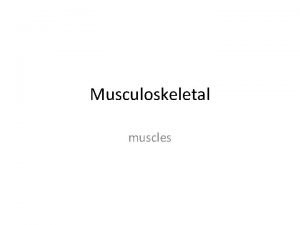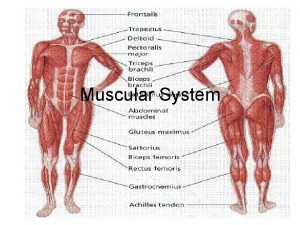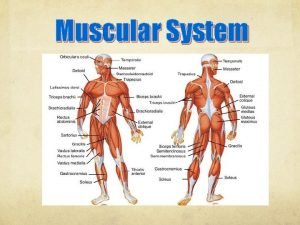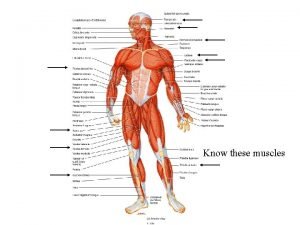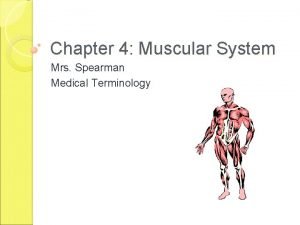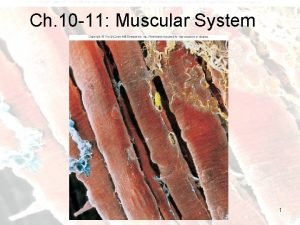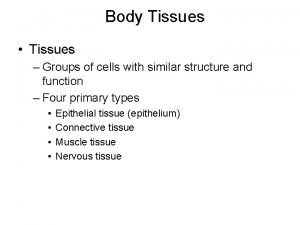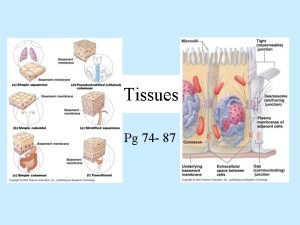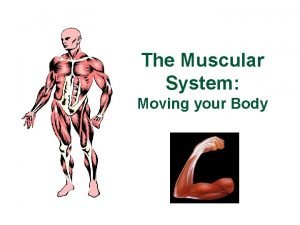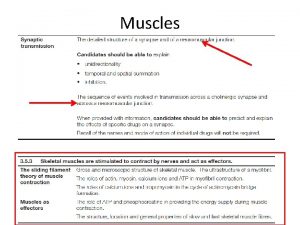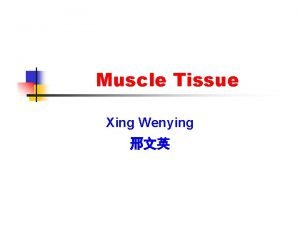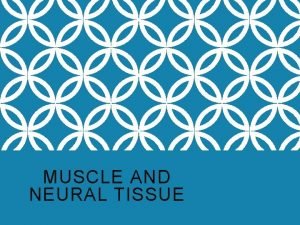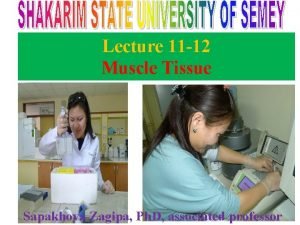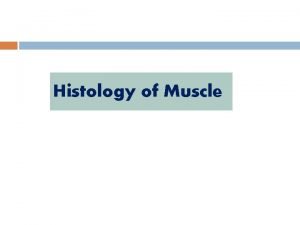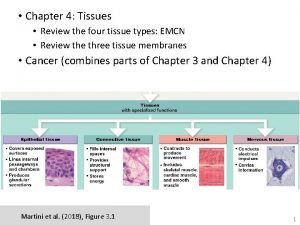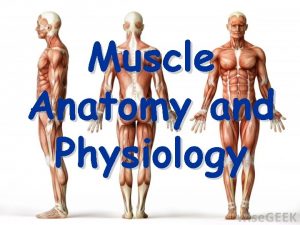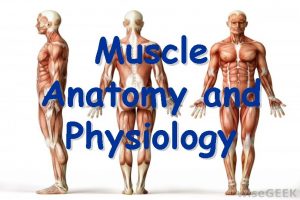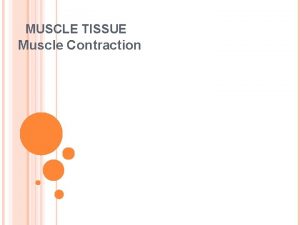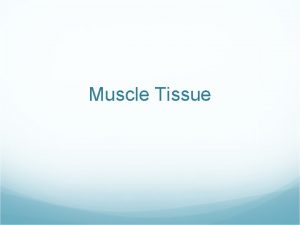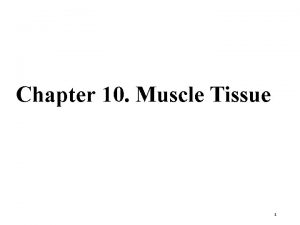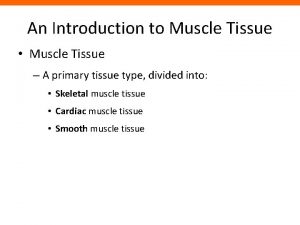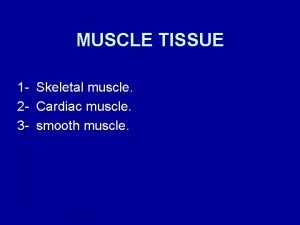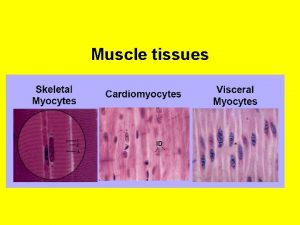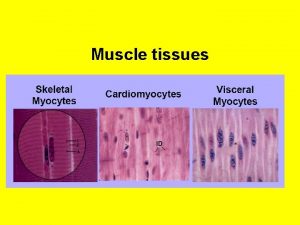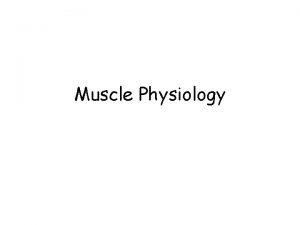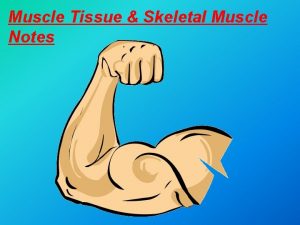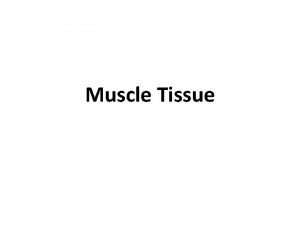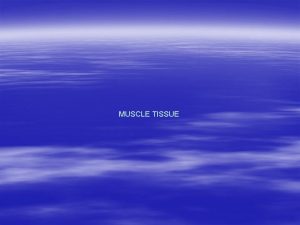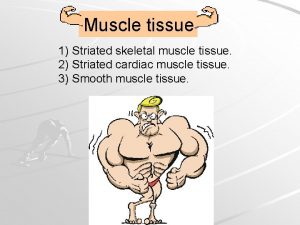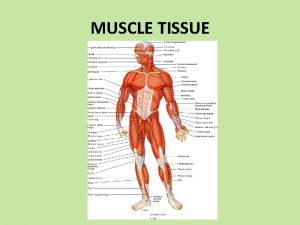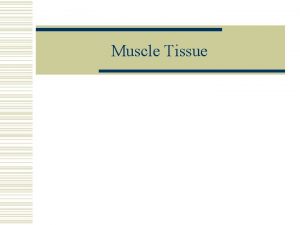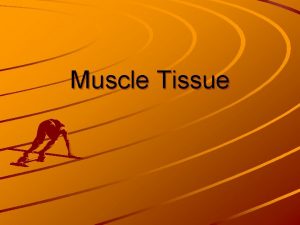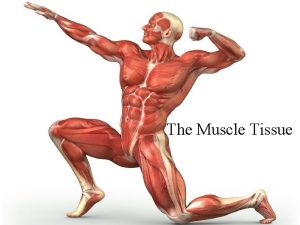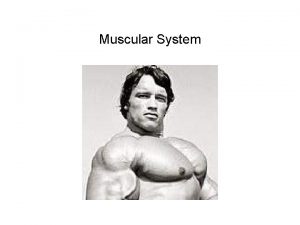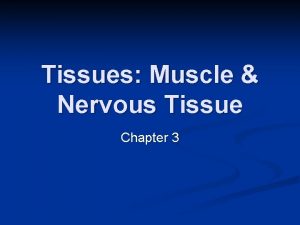An Introduction to Muscle Tissue A primary tissue



































- Slides: 35

An Introduction to Muscle Tissue § A primary tissue type, divided into § Skeletal muscle § Cardiac muscle § Smooth muscle

An Introduction to Muscle Tissue § Skeletal Muscles § Are attached to the skeletal system § Allow us to move § The muscular system § Includes only skeletal muscles

Functions of Skeletal Muscles § Produce skeletal movement § Maintain body position § Support soft tissues § Guard openings § Maintain body temperature § Store nutrient reserves

Skeletal Muscle Structures § Muscle tissue (muscle cells or fibers) § Connective tissues § Nerves § Blood vessels

Skeletal Muscle Structures § Organization of Connective Tissues § Muscles have three layers of connective tissues § Epimysium: – exterior collagen layer – connected to deep fascia – Separates muscle from surrounding tissues § Perimysium: – surrounds muscle fiber bundles (fascicles) – contains blood vessel and nerve supply to fascicles § Endomysium: – surrounds individual muscle cells (muscle fibers) – contains capillaries and nerve fibers contacting muscle cells – contains myosatellite cells (stem cells) that repair damage

Skeletal Muscle Structures Figure 10– 1 The Organization of Skeletal Muscles.

Skeletal Muscle Structures § Organization of Connective Tissues § Muscle attachments § Endomysium, perimysium, and epimysium come together: – at ends of muscles – to form connective tissue attachment to bone matrix – i. e. , tendon (bundle) or aponeurosis (sheet)

Skeletal Muscle Structures § Nerves § Skeletal muscles are voluntary muscles, controlled by nerves of the central nervous system (brain and spinal cord) § Blood Vessels § Muscles have extensive vascular systems that § Supply large amounts of oxygen § Supply nutrients § Carry away wastes

Skeletal Muscle Fibers § Are very long § Develop through fusion of mesodermal cells (myoblasts) § Become very large § Contain hundreds of nuclei

Skeletal Muscle Fibers Figure 10– 2 The Formation of a Multinucleate Skeletal Muscle Fiber.

Skeletal Muscle Fibers Figure 10– 2 a The Formation of a Multinucleate Skeletal Muscle Fiber.

Skeletal Muscle Fibers Figure 10– 2 b The Formation of a Multinucleate Skeletal Muscle Fiber.

Skeletal Muscle Fibers § Internal Organization of Muscle Fibers § The sarcolemma § The cell membrane of a muscle fiber (cell) § Surrounds the sarcoplasm (cytoplasm of muscle fiber) § A change in transmembrane potential begins contractions

Skeletal Muscle Fibers § Internal Organization of Muscle Fibers § Transverse tubules (T tubules) § Transmit action potential through cell § Allow entire muscle fiber to contract simultaneously § Have same properties as sarcolemma

Skeletal Muscle Fibers § Internal Organization of Muscle Fibers § Myofibrils § Lengthwise subdivisions within muscle fiber § Made up of bundles of protein filaments (myofilaments) § Myofilaments are responsible for muscle contraction § Types of myofilaments: – thin filaments: » made of the protein actin – thick filaments: » made of the protein myosin

Skeletal Muscle Fibers § Internal Organization of Muscle Fibers § Sarcoplasmic reticulum (SR) § A membranous structure surrounding each myofibril § Helps transmit action potential to myofibril § Similar in structure to smooth endoplasmic reticulum § Forms chambers (terminal cisternae) attached to T tubules

Skeletal Muscle Fibers § Internal Organization of Muscle Fibers § Triad § Is formed by one T tubule and two terminal cisternae § Cisternae: – concentrate Ca 2+ (via ion pumps) – release Ca 2+ into sarcomeres to begin muscle contraction

Skeletal Muscle Fibers Figure 10– 3 The Structure of a Skeletal Muscle Fiber.

Skeletal Muscle Fibers § Internal Organization of Muscle Fibers § Sarcomeres § The contractile units of muscle § Structural units of myofibrils § Form visible patterns within myofibrils § Muscle striations § A striped or striated pattern within myofibrils: – alternating dark, thick filaments (A bands) and light, thin filaments (I bands)

Skeletal Muscle Fibers § Internal Organization of Muscle Fibers § Sarcomeres § M Lines and Z Lines: – M line: » the center of the A band » at midline of sarcomere – Z lines: » the centers of the I bands » at two ends of sarcomere

Skeletal Muscle Fibers § Internal Organization of Muscle Fibers § Sarcomeres § Zone of overlap: – the densest, darkest area on a light micrograph – where thick and thin filaments overlap § The H Band: – the area around the M line – has thick filaments but no thin filaments

Skeletal Muscle Fibers § Internal Organization of Muscle Fibers § Sarcomeres § Titin: – are strands of protein – reach from tips of thick filaments to the Z line – stabilize the filaments

Skeletal Muscle Fibers Figure 10– 4 a Sarcomere Structure.

Skeletal Muscle Fibers Figure 10– 4 b Sarcomere Structure.

Skeletal Muscle Fibers Figure 10– 5 Sarcomere Structure.

Skeletal Muscle Fibers Figure 10– 6 Levels of Functional Organization in a Skeletal Muscle.

Skeletal Muscle Fibers Figure 10– 6 Levels of Functional Organization in a Skeletal Muscle.

Skeletal Muscle Fibers § Sarcomere Function § Transverse tubules encircle the sarcomere near zones of overlap § Ca 2+ released by SR causes thin and thick filaments to interact

Skeletal Muscle Fibers § Muscle Contraction § Is caused by interactions of thick and thin filaments § Structures of protein molecules determine interactions

Skeletal Muscle Fibers § Four Thin Filament Proteins § F-actin (Filamentous actin) § Is two twisted rows of globular G-actin § The active sites on G-actin strands bind to myosin § Nebulin § Holds F-actin strands together § Tropomyosin § Is a double strand § Prevents actin–myosin interaction § Troponin § A globular protein § Binds tropomyosin to G-actin § Controlled by Ca 2+

Skeletal Muscle Fibers Figure 10– 7 a, b Thick and Thin Filaments.

Skeletal Muscle Fibers § Initiating Contraction § Ca 2+ binds to receptor on troponin molecule § Troponin–tropomyosin complex changes § Exposes active site of F-actin

Skeletal Muscle Fibers § Thick Filaments § Contain twisted myosin subunits § Contain titin strands that recoil after stretching § The mysosin molecule § Tail: – binds to other myosin molecules § Head: – made of two globular protein subunits – reaches the nearest thin filament

Skeletal Muscle Fibers Figure 10– 7 c, d Thick and Thin Filaments.

Skeletal Muscle Fibers § Myosin Action § During contraction, myosin heads § Interact with actin filaments, forming cross-bridges § Pivot, producing motion
 Gap junctions in smooth muscle
Gap junctions in smooth muscle Toe dancers muscle a two bellied muscle of the calf
Toe dancers muscle a two bellied muscle of the calf Skeletal muscle tone
Skeletal muscle tone Muscle tissue
Muscle tissue Cardiac muscle
Cardiac muscle Eccentric movement
Eccentric movement Tropomyosin muscle contraction
Tropomyosin muscle contraction Classification of muscle tissue
Classification of muscle tissue Skeletal muscle tissue description
Skeletal muscle tissue description Muscles and muscle tissue chapter 9
Muscles and muscle tissue chapter 9 John wiley & sons
John wiley & sons Type of tissue
Type of tissue Wave summation
Wave summation Teased smooth muscle
Teased smooth muscle Muscle tissue
Muscle tissue Muscle tissue
Muscle tissue Muscle tissue parts
Muscle tissue parts Cardiac muscle tissue
Cardiac muscle tissue Types of muscle tissue
Types of muscle tissue Types of muscle tissue
Types of muscle tissue Tissue that connects muscle to bone
Tissue that connects muscle to bone Muscular tissue function
Muscular tissue function The medical term for hiccup is _____.
The medical term for hiccup is _____. Skeletal muscle tissue structure
Skeletal muscle tissue structure Similar pictures
Similar pictures Muscle tissue parts
Muscle tissue parts What is a tissue?
What is a tissue? Types of muscle tissue
Types of muscle tissue Muscle cells
Muscle cells Structure of muscle cell
Structure of muscle cell What are the characteristics of nervous tissue
What are the characteristics of nervous tissue Function of muscle tissue
Function of muscle tissue Cardiac muscle tissue
Cardiac muscle tissue Cardiac muscle tissue
Cardiac muscle tissue How is aerolar tissue different than aerenchyma tissue?
How is aerolar tissue different than aerenchyma tissue? What are the primary tissue types
What are the primary tissue types


